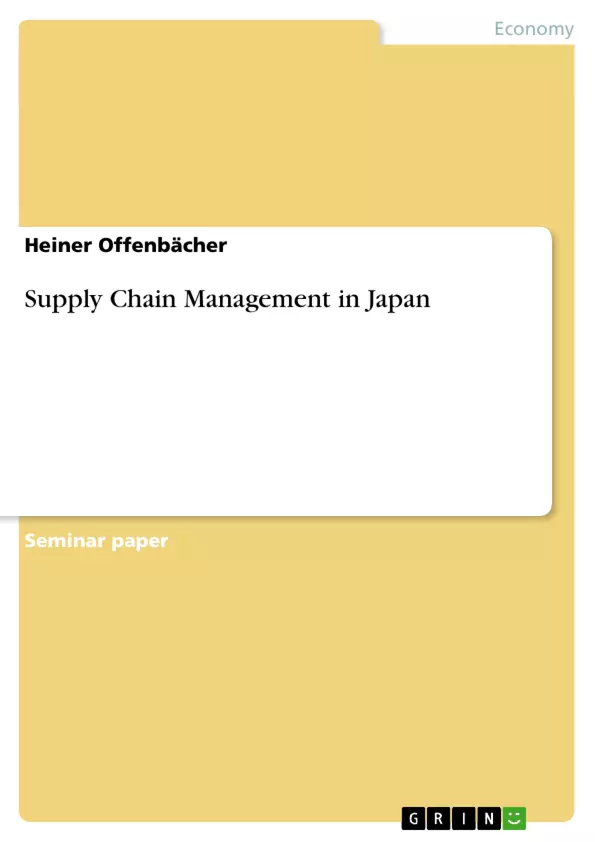The stunning success of Japanese corporations during the last decades has raised several questions and drawn profound interest for this topic in the academic literature. It has been argued by several researchers that an important part of the Japanese competitive advantage stems from its supply base that is actively managed as an extension of the enterprise. As the face of global competition changes from inter-firm to intercoalition competition taking place between whole supply chains, effective management of value chain partnerships has become a critical success factor. In contrast to Western corporations, which rely heavily on either arm’s length market transactions or vertically integrated hierarchies, hybrid governance structures in the form of inter-organizational Keiretsu business groups play a dominant role in Japan. In complex-product industries Keiretsu business groups account for a major share of Japanese competitive advantage: they foster mutual trust, specialization, information sharing and low transaction costs. Despite these advantages and the impressive track record, the historically grown Keiretsu structure is forced to adapt to changing market circumstances and undergoing a transformation. This article seeks to shed some light on the evolution of Keiretsu, assess its strengths and weaknesses and depict recent challenges and developments.
Inhaltsverzeichnis (Table of Contents)
- Introduction
- Course of the analysis
- Generic governance structures
- Underlying principles of new institutional economics
- Market
- Hierarchy
- Cooperation as a hybrid
- Business groups in Japan
- Zaibatsu
- Keiretsu business groups
- Keiretsu as a governance form for supply chain cooperation
- Classification of Keiretsu governance
- Case study: Keiretsus in the Japanese automotive industry
- Critical evaluation
- Conclusion and outlook
Zielsetzung und Themenschwerpunkte (Objectives and Key Themes)
This paper aims to analyze the potential of Keiretsu business groups as a governance structure for managing collaborations in the supply chain. It examines the evolution, strengths, weaknesses, and recent challenges of Keiretsu in the context of changing market circumstances.
- The role of new institutional economics theory in understanding supply chain governance
- The evolution and characteristics of business groups in Japan, particularly Keiretsu
- The effectiveness of Keiretsu as a hybrid governance structure for supply chain cooperation
- The strengths and weaknesses of Keiretsu governance in the Japanese context
- The ongoing transformation of Keiretsu in response to changing market dynamics
Zusammenfassung der Kapitel (Chapter Summaries)
- Introduction: Introduces the topic of Japanese corporations' success and the importance of supply chain management, highlighting the role of Keiretsu business groups as a hybrid governance structure.
- Course of the analysis: Outlines the paper's structure and its five consecutive parts, including an examination of new institutional economics theory, generic governance structures, business groups in Japan, and the analysis of Keiretsu from a theoretical perspective.
- Generic governance structures: Discusses the underlying principles of new institutional economics theory, including transaction-cost and principal agent theory, as a framework for analyzing Keiretsu business groups.
- Business groups in Japan: Examines the evolution of business groups in Japan, focusing on Zaibatsu and Keiretsu business groups.
- Keiretsu as a governance form for supply chain cooperation: Analyzes Keiretsu business groups from a new institutional theoretical perspective, classifying them within the three generic governance structures and discussing their strengths and weaknesses.
- Case study: Keiretsus in the Japanese automotive industry: Provides a practical example of Keiretsu in action, illustrating their relevance in the automotive industry.
- Critical evaluation: Discusses recent changes and problems arising within the Keiretsu group, exploring its adaptability to changing market circumstances.
Schlüsselwörter (Keywords)
This study examines the core concepts of Keiretsu business groups, new institutional economics theory, supply chain management, hybrid governance structures, transaction costs, principal agent theory, Japanese automotive industry, and the changing dynamics of business groups in a globalized market.
- Quote paper
- Heiner Offenbächer (Author), 2005, Supply Chain Management in Japan, Munich, GRIN Verlag, https://www.grin.com/document/69322



